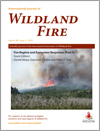International Journal of Wildland Fire
Volume 28
Number 5 2019
Fire Regime and Ecosystem Responses (Part 1)
We present a special issue conceived as a collection of research studies covering a wide diversity of geographical settings, climates and forest types. Here, the first section (of two) comprises six novel studies on adaptions to fire regimes, burn severity and plant–soil interface or post-fire management by using satellite images, dendrochronology, soil sampling and analysis of biological indicators.
To assess long-term post-fire resilience in Mediterranean pine forests from central Spain, we reconstructed historical fire dynamics by using charcoal accumulation rates and pollen data, historical fire records, and tree-ring width data. We documented an abrupt regime shift during the 1890s characterised by high-severity fires, which changed pinewoods composition.
Laboratory tests using a mass loss calorimeter were carried out to quantify the influence of bark thickness on flammability and resistance of Pinus pinea L. (stone pine) trunks to fire. Data from permanent plots were used to generate a new linear mixed model to predict bark thickness along the trunk in Spanish stone pine stands. The model suggests critical thresholds of charring height in order to evaluate fire severity after wildfires and prescribed burning and to design preventive silviculture.
We analysed the impacts of burn severity on soil properties immediately after fire. Physical (mean weight diameter), chemical (pH, available P, organic C) and biological (microbial biomass C, β-glucosidase and acid phosphatase activities) soil properties, as well as soil quotients (C : N, microbial quotient, β-glucosidase : microbial biomass C) were significantly affected by burn severity.
We determine how post-fire salvage logging (SL) v. without logging (WL) affected Austrocedrus chilensis seedling survival and growth under different aerial and root-competition treatments. High radiation levels at SL sites precluded A. chilensis seedlings survival, whereas aerial or root competition had insignificant effects. Remaining snags at WL sites attenuate radiation, allowing high seedling survival.
Various studies suggest that fire-induced erosion rates sharply increase after the fire and gradually decrease during the first few years. This study addresses the effect of post-fire management practices on soil erosion, 3–4 years after the fire. The main result indicates that the most effective practices are those that provide surface cover. Spreading wood chips significantly mitigated erosion, whereas all other practices inhibited vegetation renewal and system rehabilitation for longer periods.
The reestablishment of natural fire regimes in red fir forests reduced stand densities, increased understorey species richness and restored spatial heterogeneity. Forest health indicators were similar between burned and unburned sites, and crown loss ratings were associated with topographic variables indicative of increased moisture stress or reduced soil moisture availability.





